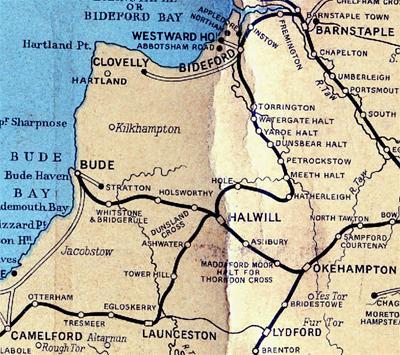History of the Parish

Origins
The Parish of Halwill has a name that recalls the religious beliefs of Medieval and Dark Age Devonians. Indeed, when first used, 'Halwill' would have been written 'Halig' or 'Halge Wylle'. Reading it out loud, we might guess that 'wylle' is the ancient word for 'well'; but 'halig'—the early version of our word 'holy'—needs a specialised dictionary.
So what you might ask went on at a Holy Well in north-central Devon? Here we have a spring which had sacred or miraculous associations for the people. As the name was coined in Old English rather than Celtic we must suppose it dates from the Christian centuries when the Anglo-Saxons, the early English, were settling in Devon. But Christian holy wells were often associated with Pagan shrines and even Neolithic monuments, suggesting that they had not only Pagan but even Stone Age origins. So though given an English name in the Dark ages, the spring at Halwill might have already been revered for centuries by the time the first person was muttering their blessings over it.
Today the site of the original Holy Well has been lost, though it is believed by many to be sited close to the Holsworthy road near to Chapel Farm. If anyone knows more, or has evidence of a precise location, please let us know.
[Most of the above is based on a press cutting, the origin of which—like the well—has been lost in the mists of time. If anyone knows who the author is we'll be happy to give it a proper credit.]
Railway History
Halwill Junction, although not the size of Crewe, was a major junction for Devon and the map above shows the links with stations from Bideford and Barnstaple in the north to Bude, Camelford and Launceston in the south.
The station was opened in January 1879 by the London and South Western Railway (LSWR) following the extension of its line from Meldon Junction on the Okehampton to Plymouth line to Holsworthy on the new Bude Branch. Five years later, it became a junction station with the construction by the North Cornwall Railway of a line south to Launceston which gave the latter company a direct through route over LSWR metals to London Waterloo. The opening of the route south led to the renaming of the station - to Halwill Junction - in March 1887. By the close of the century both lines had been extended - the Bude Branch reaching Bude by 10 August 1898 and the North Cornwall Line to Padstow by 23 March 1899.
A third route stretching out to the north towards Torrington was opened on 27 July 1925 by the North Devon and Cornwall Junction Light Railway. This was served by a separate uncovered platform outside the main station building, situated to the north. The station now became officially known as Halwill, although its running-in board provided a fuller description of the routes available, proudly announcing Halwill for Beaworthy, junction for the Bude, North Cornwall & Torrington Lines.
Always a slightly odd station in the sense that it served no particular large urban conurbation and acted largely as a useful interchange between three different lines, Halwill was at its busiest in the period up to the Second World War when eight sidings were laid to deal with the military traffic in the lead-up to D-Day. It also relied, as did the lines which it served, to a large extent on summer holiday traffic and when this began to dry-up in the late 1950s and early 1960s with the increased use of the motorcar, it became unprofitable and a candidate for closure in the Beeching Report. First proposed for closure in April 1964, Halwill saw its connecting lines close one by one over the next few years - the line north to Torrington closed to passengers on 1 March 1965 and those to Bude and Padstow on 3 October 1966, heralding the end for the formerly important railway junction. The line north did, however, remain open between Torrington and Barnstaple for freight until 1982.




